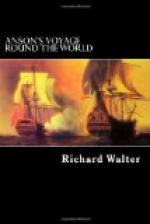The trade carried on from Manila to China, and different parts of India, is principally for such commodities as are intended to supply the kingdoms of Mexico and Peru. These are spices; all sorts of Chinese silks and manufactures, particularly silk stockings, of which I have heard that no less than 50,000 pairs were the usual number shipped on board the annual ship; vast quantities of Indian stuffs—as calicoes and chintzes, which are much worn in America; together with other minuter articles—as goldsmith’s work, etc., which is principally done at the city of Manila itself by the Chinese, for it is said there are at least 20,000 Chinese who constantly reside there, either as servants, manufacturers, or brokers. All these different commodities are collected at Manila, thence to be transported annually in one or more ships to the port of Acapulco.
THE Manila SHIP.
This trade from Manila to Acapulco and back again is usually carried on in one or at most two annual ships, which set sail from Manila about July, arrive at Acapulco in the December, January, or February following, and, having there disposed of their effects, return for Manila some time in March, where they generally arrive in June, so that the whole voyage takes up very near an entire year. For this reason, though there is often no more than one ship employed at a time, yet there is always one ready for the sea when the other arrives, and therefore the commerce at Manila are provided with three or four stout ships that, in case of any accident, the trade may not be suspended. The largest of these ships, whose name I have not learned, is described as little less than one of our first-rate men-of-war, and indeed she must be of an enormous size, for it is known that when she was employed with other ships from the same port to cruise for our China trade, she had no less than 1,200 men on board. Their other ships, though far inferior in bulk to this, are yet stout, large vessels, of the burthen of 1,200 tons and upwards, and usually carry from 350 to 600 hands, passengers included, with fifty odd guns. As these are all King’s ships, commissioned and paid by him, there is usually one of the captains who is styled the “General,” and who carries the royal standard of Spain at the main-topgallant masthead.
The ship having received her cargo on board and being fitted for the sea, generally weighs from the mole of Cabite about the middle of July, taking advantage of the westerly monsoon which then sets in to carry them to sea. When they are clear of the islands they stand to the northward of the east, in order to get into the latitude of thirty odd degrees, when they expect to meet with westerly winds, before which they run away for the coast of California. It is most remarkable that, by the concurrent testimony of all the Spanish navigators, there is not one port, nor even a tolerable road, as yet found out betwixt the Philippine Islands and the coast of California and Mexico,* so that from the time the Manila ship first loses sight of land she never lets go her anchor till she arrives on the coast of California, and very often not till she gets to its southernmost extremity.




